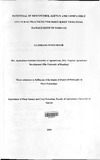| dc.description.abstract | Root-knot nematodes (Meloidogyne spp.) are among the major constraint to profitable tomato
production in Kenya. This study was conducted to determine the efficacy of biocontrol
agents, organic amendments, crop rotation and an integrated management package of the
nematodes in tomato. Six isolates of Pochonia chlamydosporia and one isolate of
Paecilomyces lilacinus were screened against root-knot nematodes in vitro, under glasshouse
and field conditions. The isolates selected after the initial evaluation were tested against rootknot
nematodes in combination with organic materials. The organic materials namely bean
straw, cabbage leaves, Crotalaria ochroleuca, cow, goat and chicken manure, filtermud,
maize stover, maize cobs, Mucuna pruriens, rice husk, sawdust, Tagetes minuta and Tithonia
diversifolia were tested for ability to support growth and production of chlamydospores of
fungal isolate 10. The isolate was applied in a rotation cycle involving maize and tomato in
the first season which was followed by only tomato in the second season. Maize stover was
also incorporated in the second season as a soil amendment. Among the fungal isolates
screened, isolates 10 and 392 of Pochonia chlamydosporia were the most potent in
parasitizing eggs of root-knot nematodes. At 30 days, the significant (P<O.OS) higher fungal
propagules was from isolates 10 in sterile soil (1.SxI03
) and 392 in non sterile soil (6xI03
)
than from isolate 10, PI-20K and PI-plus «8.2x 102
) in non sterile soil. The highest shoot
weight (8.Sg/plant) was recorded in tomato plants grown in sterile soil to which isolate 392
was applied. The evaluation of locally available materials for the production of viable
chlamydospores showed that, Mucuna pruriens, maizecobs, Tithonia diversifolia, Tagetes
minuta, goat manure and bean straw are promising substrates with comparable efficacy to
rice (standard). For instance, chlamydospore counts were between 9 to 43x 106/g of organic
substrate having 50-62% viability while rice had 7.8x106 chlamydospores/g with 48%
viability. Addition of organic materials and the fungus significantly increased the dry shoot
weight compared to treatments without the fungus. Among the organic materials used,
maizestover and Tithonia diversifolia had 64-65% higher shoot weight than the control.
Incubation of organic material and fungus for 30 days increased the fungal propagules of
Pochonia chlamydosporia in the soil and rhizosphere compared to application at planting. A
higher percentage of nematode egg infection was recorded on extracts from rice (53%),
sawdust (42%), filtermud (38%), ricehusk (37%), Crotalaria ochroleuca (26%) and
maizecobs (22%) than the other substrates. The incubation of Crotalaria ochroleuca, maize
cobs and sawdust at 15, 20 or 25°C, significantly increased the percentage of egg infection
and the number of fungal propagules in the soil. Under glasshouse conditions, 28 and 58%
reduction in numbers of second stage juveniles was recorded when the fungus was applied to
tomato and maize in the first season, respectively. A combined application of the fungus and
maize stover resulted in 50% decrease in numbers of second-stage juveniles in tomato roots.
Application ofthe fungus in a rotation cycle involving maize in the first season and tomato in
the second season led significant a decline in root galling indices from 1.7 to 1.1. In addition,
combining crop rotation with the fungus resulted in an increase in yield of tomato by 39 to
63%. | en |

